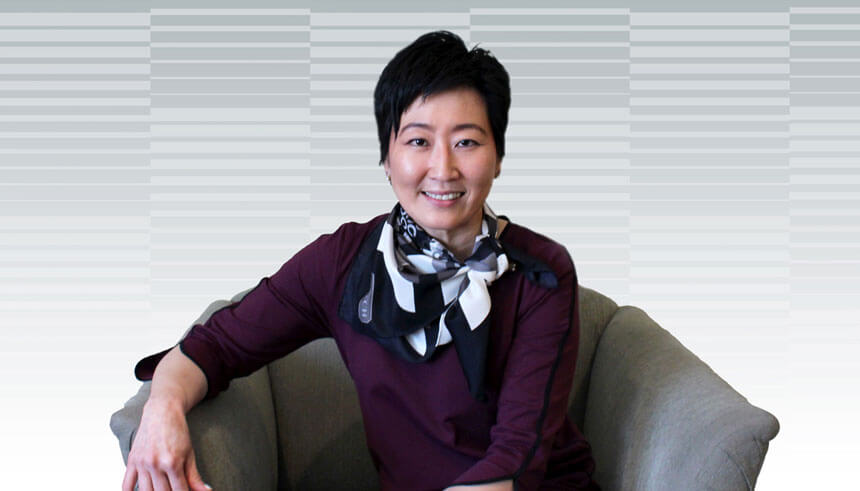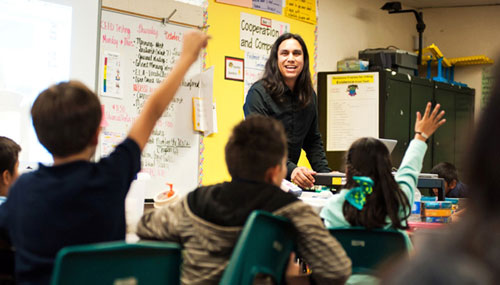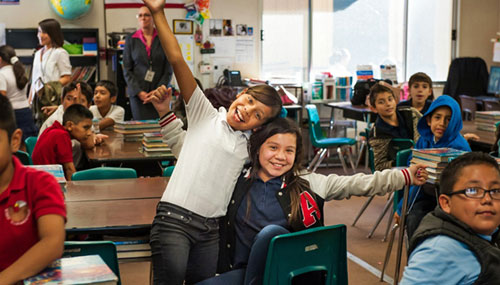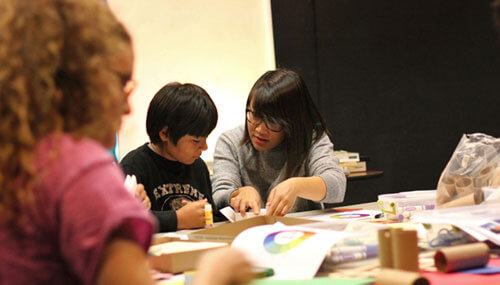Bull Session
Jin Sung: From Arts Mentorship to Public Advocacy
By Angela Bao

Jin Sung is the founder and executive director of OASIS Center International, a Santa Ana, Calif.-based nonprofit organization focused on arts mentorship in low-income communities. East West Bank has partnered with OASIS to support their afterschool arts programs for low- and moderate-income students and community events like the OASIS Arts Festival. As a former strategic planner, Sung offers her unique perspective on how a nonprofit can—and should—leverage its resources beyond its cause and influence public policy.
How does OASIS use arts mentorship to help students?
We partner with Title I schools, specifically elementary schools, and provide afterschool arts programming to low-income communities. Title I schools generally have limited access to educational resources, and we always want to be some type of bridge organization that can help them with any added-value programs. Working with schools that do not have access to any type of arts education, the first thing is to provide the basic classes; all of our classes are introductory level but have a special emphasis on mentorship.
In 2014, OASIS implemented its first pilot arts program with 50 students in Santa Ana. We implemented a program called BEEP—Built Environment Educational Program—where we partnered with architectural firms to engage local architects, engineers, and designers to mentor our students. Many of our programs give opportunities to students to interact directly with arts practitioners, giving them direct input on the realities of arts space.
About 98 percent of the students we served are Hispanic, and it was truly heartwarming to see that all 50 students who participated in the pilot program say, “I want to become an architect.” That’s very impressive because there is a very small percentage of Hispanics in the engineering field. We know that, just by the testimonials of our children alone, we have outpaced the current statistics.

"We believe that arts and mentorship have the power to divert from at-risk environments or behaviors."
We purposefully focus our programs on elementary schoolers because when you look at the gang recruitment data, the target age for recruitment is 12 years old. We try to intervene right before the target age so that our children can say no to gangs, drugs, and violence because they have better things ahead of them and continue on with their life aspirations. Our motto is “Art Leads” because we believe that arts and mentorship have the power to divert from at-risk environments or behaviors.
What inspired you to start OASIS Center International?
Children who’ve been exposed to the arts at a young age are more likely to begin reading at earlier age, score higher on math competencies, become leaders later in life, or just more likely to be productive children. Simply put, this research is real, but unfortunately our school systems are not adding funding toward arts education.
Arts education has been cut statewide. It wasn’t designated that arts education be slashed, but one of the first things that goes is education that’s geared toward long-term success. This reads another kind of problem in our societies, because the creativity and ingenuity has been slashed out. They say the job market is really high, but we don’t have qualified candidates to fill those spots. This is a very serious issue when you look at it from that perspective; they don’t understand the arts, not only from a creativity and educational standpoint, but also as an economic development force.
So, when you look at the public elementary schools, it’s very clear that a lot of the programs being driven by creativity and innovation—arts and culture, in general—don’t exist or is very minimal. That’s when we decided that this is an area where we can really bring impact to our community.
Your program has been active for only three years, yet you’ve already impacted over 2,000 low- to middle-income students. What do you think contributed to your success?
People are very important, and great people are what produces results. OASIS has nine board of directors, all from diverse industries who bring specific gift sets. As the founder, I make sure that all people involved are vested in the vision and the work. We promote a learning culture within the board that emphasizes identity and full commitment to the success of the organization. Whether they are staff, a volunteer, or a board member, it is important for me to see that each of them feels like they are OASIS. That identity portion is extremely important for them.
"Children who’ve been exposed to the arts at a young age are more likely to…become leaders later in life."

OASIS has quite the diverse list of partners. How did you develop the types of relationships necessary to make a successful nonprofit, and from such a variety of industries?
We understand that partnership really enhances impact. The types of people and organizations that we’re looking for are the ones that are committed for long-term success. They need to be vested in the cause, see the organization at large, and understand that it takes time for success to really happen. Working together with public sectors scales you to a different level because the level of introduction you get is at a greater scale and makes it easier. We’re becoming smarter as an organization, and learning how to leverage and make things work in the most pressing situations.
It is the same with corporate partners. It’s all about relationship—being a true advocate for the partners that are aligned with our vision allows for our program sustainability. I don’t think anyone should give just for the sake for giving—I really feel that is has to be a handshake. When there is a need in both parties, then it will last.
There’s also a huge trust factor that needs to be in place for our type of work to flourish. One of the principals of the schools told me in the beginning of our partnership, “You know, your program sounds so great, I just hope you don’t take off after the first year.” And my answer was, “No, we’re here to stay.” So far, we’ve kept up our promise, and I believe it will be a kept promise.
How do you maintain a sustainable business model?
You would think nonprofits are treated differently than for-profits, but the answer is no. The only difference is that nonprofits don’t get taxed on its income. Everything else, the government agencies treat you like a business.

"Nonprofits do not just exist for social welfare, i.e. the “cause.” The “cause” has to be driven to public policy making."
As an organization, we’re also learning that the risks need to be calculated in, in order to be a robust company. I say company because I feel that nonprofits should not be stereotyped as organizations that should not operate at a profit—we should. The way that I run the organization is to make sure that we are sustainable and profitable, and we’re just putting the profits back into the mission. The No. 1 concern for any nonprofit is funding. It doesn’t matter how great of a program you have: if you don’t have funding, it dies.
What is one piece of advice you’d give to someone who wants to start a nonprofit?
Nonprofits do not just exist for social welfare, i.e. the “cause.” The “cause” has to be driven to public policy making. What’s the whole point? You can do all the hard work on the bottom level, but if the regulators and decision makers in the government don’t understand what’s happening at the grassroots level, then all you’re doing is working really hard.
One of the things I learned in the process is that there are two major responsibilities that you have as a nonprofit organization or a nonprofit leader. One is obviously a programming element, as a grassroots organization. The other is to engage in public policy work. Our work is really tied horizontally and vertically; meaning, we do the community work like arts mentorship, as that’s our platform. The other element is recognizing the fact that a lot of our constituents don’t have a voice in the political arena. We make sure that their voices are heard in Sacramento, or even in Washington D.C.
Sign up for the Reach Further Newsletter
We’ll keep you in the know about the latest US-Asia business news and trends.
Suscríbase al boletín Reach Further
Lo mantendremos informado sobre las últimas noticias y tendencias comerciales entre Estados Unidos y China.

